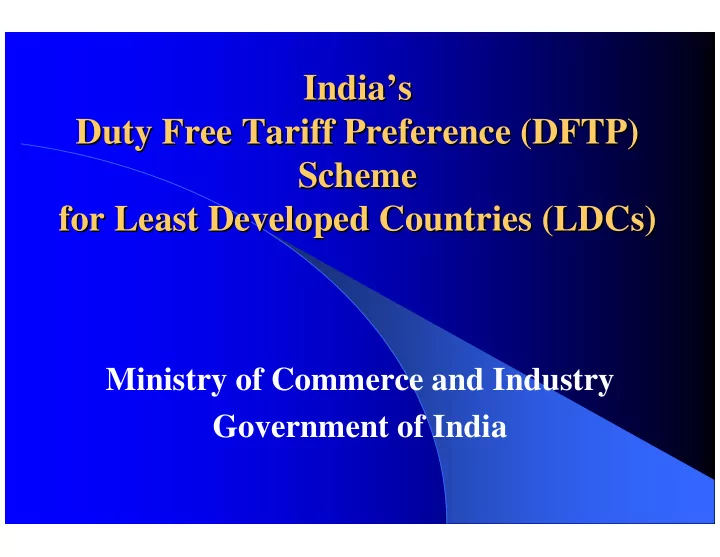

India’ ’s s India Duty Free Tariff Preference (DFTP) Duty Free Tariff Preference (DFTP) Scheme Scheme for Least Developed Countries (LDCs) for Least Developed Countries (LDCs) Ministry of Commerce and Industry Government of India
Mandate Mandate � Duty Free Quota Free (DFQF) market access under WTO’s Hong Kong Ministerial Declaration, 2005. � Developed countries and developing countries declaring themselves in a position to do so, to provide market access for at least 97% of products originating from LDCs. � � Developing countries permitted to phase in their commitments and enjoy appropriate flexibility in coverage.
India’ ’s DFTP Scheme s DFTP Scheme India � What is DFTP Scheme: DFTP is a unilateral tariff preference scheme which provides both duty free and preferential market access on products comprising 92.5% of global exports of all LDCs. � When announced: Announced by Indian Prime Minister during India-Africa Forum Summit on 8 April, 2008 in New Delhi. � Coverage: 49 Least Developed Countries (33 in Africa, 16 in Asia- Pacific & 1 in Americas).
DFTP Model DFTP Model � Product Coverage � Positive List (with margin of preference) – 9% lines � Exclusion List (no tariff preferences) – 6% lines � All other products are duty free – 85% lines � Reduction process: � 5 equal cuts � 5 year implementation period � Rules of Origin � CTH + 30%
DFTP Coverage DFTP Coverage � Total Coverage: 94% of India’s tariff lines � Products of export interest for LDCs � Cotton � Cocoa � Aluminium ores � Copper ores � Cashew nuts � Cane sugar � Readymade garments � Fish fillets � Non-industrial diamonds
DFTP Coverage DFTP Coverage � Duty Free Access: 85% of India’s tariff lines � Products of Export Interest for LDCs � Some Marine products � Some milk and milk products � Vegetables, fruits and nuts � Some Edible oils � Ores and minerals � Textiles � Clothing � Some Footwear � Gems and jewellery (diamonds, pearls)
DFTP Coverage DFTP Coverage � Preferential Duty Access 9% of India’s tariff lines � Products of Export Interest for LDCs � Marine products – 20% MOP per year � Edible vegetables (leguminous) – 5% MOP per year � Edible fruits and nuts (coconuts, arecanuts etc) - 2-12% MOP per year � Spices (chilly, cinnamon, cloves, ginger, turmeric)- 3-18% MOP per year � Edible oil (groundnut, sunflower, cococut etc) - 10% MOP per year � Cane, beet and refined sugar -10% MOP per year � Soaps – 10-12% MOP per year � Plastics(scrap, tubes/pipes, floor coverings, plates/sheets) – 10% MOP py � Rubber products (latex, smoked sheets) – 2-10% MOP per year � Clothing – 10-12% MOP per year � Footwear – 2-15% MOP per year
DFTP Coverage DFTP Coverage � Exclusion List 6% of India’s tariff lines � Products covered � Some milk products (concentrated milk, butter, dairy spreads, cheese) � Some vegetables (potato seeds, onions, garlic, cauliflowers, lettuce) � Some fruits and nuts (almonds, walnuts, betelnuts, figs, lemons, apples) � Coffee, tea, vanilla, cardamom � Cereals (wheat , rice, maize), Flour (wheat, potatoes), Cocoa � Marble � Rubber products � Silk yarn � Iron & steel products � Refined copper and copper alloys � Tractors
Why Beneficial ? Why Beneficial ? � Products of export interest to LDCs � Facilitate value added manufacturing in LDCs � Investment flows from India to LDCs for taking advantage of DFTP
What LDCs need to submit What LDCs need to submit � Letter of Intent (as per format circulated) � Details of authorities authorized for issuing Certificate of Origin: � Name of the Agency � Names and specimen signatures of authorized officials � Seal of Agency
Review Process Review Process � DFTP Scheme to be reviewed based on: � Inputs from Beneficiary LDCs � Performance/ Utilisation of the Scheme
Present Status (as on June, 2009) Present Status (as on June, 2009) � So far, Government of India has received Letters of Intent from 17 LDCs namely Benin, Burkina Faso, Cambodia, Eritrea, Ethiopia, Gambia, Lao PDR, Madagascar, Malawi, Mozambique, Myanmar, Rwanda, Samoa, Senegal, Sudan, Tanzania and Uganda . � Out of these, only 8 LDCs namely Benin, Cambodia, Ethiopia, Lao PDR, Malawi, Myanmar, Senegal and Tanzania have submitted details of agencies authorized to issue Certificate of Origin.
Plan of Action for DFTP beneficiaries Plan of Action for DFTP beneficiaries � Submit (if not already done so) the � Letter of Intent � List of agencies/ officials authorised to issue the Certificate of Origin � Department of Commerce/ Centre have identified the products of export interest for LDCs who have submitted all the documents � DFTP beneficiaries may concentrate on these products of export interest and tailor their policy measures accordingly
Suggestions Received Suggestions Received � Change in Rules of Origin for products of export interest: The rules of origin are uniformly applied across the DFTP Scheme. Since it is not PSRs (product specific rules), one cannot therefore pick and chose � Removal of products of export interest from Exclusion List: The DFTP Scheme would be reviewed on a regular basis based on inputs received from the beneficiaries and other sources.
THANK YOU
Recommend
More recommend